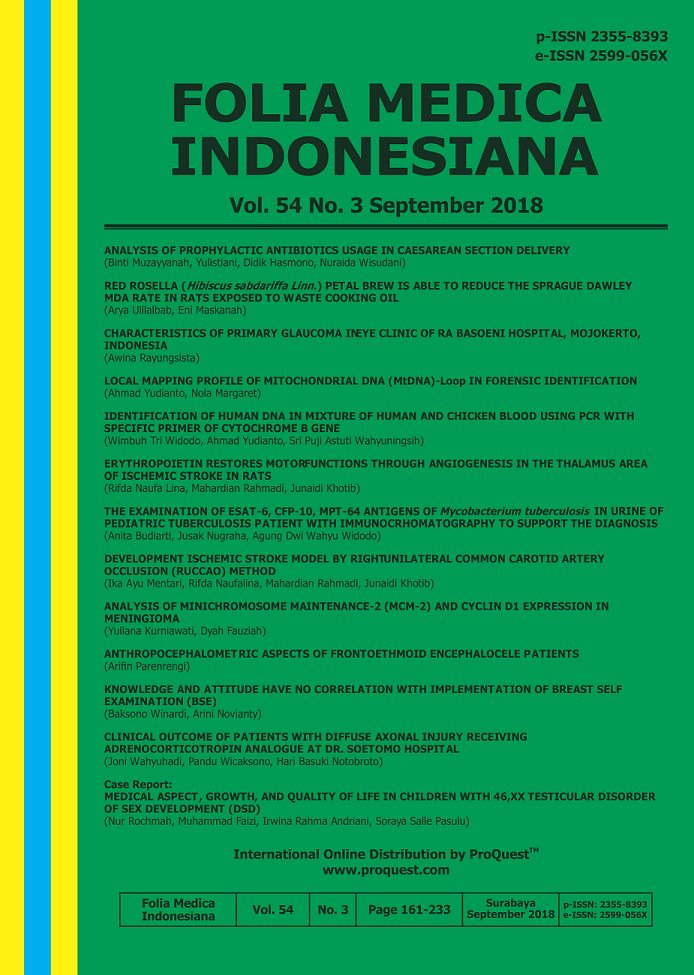Main Article Content
Abstract
Keywords
Article Details
-
Folia Medica Indonesiana is a scientific peer-reviewed article which freely available to be accessed, downloaded, and used for research purposes. Folia Medica Indonesiana (p-ISSN: 2541-1012; e-ISSN: 2528-2018) is licensed under a Creative Commons Attribution 4.0 International License. Manuscripts submitted to Folia Medica Indonesiana are published under the terms of the Creative Commons License. The terms of the license are:
Attribution ” You must give appropriate credit, provide a link to the license, and indicate if changes were made. You may do so in any reasonable manner, but not in any way that suggests the licensor endorses you or your use.
NonCommercial ” You may not use the material for commercial purposes.
ShareAlike ” If you remix, transform, or build upon the material, you must distribute your contributions under the same license as the original.
No additional restrictions ” You may not apply legal terms or technological measures that legally restrict others from doing anything the license permits.
You are free to :
Share ” copy and redistribute the material in any medium or format.
Adapt ” remix, transform, and build upon the material.

References
- Alice RI, Jodi MM (1999). Mitochondrial DNA analysis at the FBI laboratory. Forensic Science Communi-cation 1
- Anderson S, Bankier AT, Nierlich DP, Roe BA, Sanger F, Schreier PH, Smith AJH, Staden R, Young IG (1981). Sequence and organization of the human mito-chondrial genome. Nature 290, 457-465
- Atmaja DS (2005). Peranan sidik jari DNA pada bidang kedokteran forensic; Materi Workshop DNA finger-printing. Yogyakarta, Universitas Gadjah Mada, Yogyakarta.
- Butler JM, Yin S, Bruce RM (2004). The development of reduced size STR amplicons as tools for analysis of degraded DNA. National Institute of Standards and Technology
- Edward M, Golenberg, Ann B, Paul W (1996). Effect of highly fragmented DNA on PCR. Nucleic Acids Research 24
- Gabriel MN, Huffine EF, Ryan JH (2001). Improved mtDNA sequence analysis of forensic remains using a "mini-primer” set amplification strategy. J Forensic Sci 46, 247
- Innis MA, Gelfand DH (1990). Optimization of PCRs. In: PCR Protocols (Innis, Gelfand, Sninsky and White, eds.). New York, Academic Press, p 3-12
- Lusida MI, Handajani R, Purwanta M (1999). DNA sequencing. In: Biologi Molekuler Kedokteran (Putra, ST.(Ed)). Surabaya, Airlangga University Press, p 136-149
- Muladno (2002). Seputar teknologi rekayasa genetika, Bogor, Pustaka Wirausaha Muda
- Robin ED, Wong R (1988). Mitochondrial DNA molecules and number of mitochondria per cell in mamillian cells. J Cellular Physiology 136, 507-13
- Saiki RK (1985). The design and optimization of the PCR. In: PCR technology principles and applications for DNA amplification (Erlich HA ed). New York: Stocton Press
- Sudoyo H (2003). DNA sebagai marka antropologi dan kedokteran forensik. Kumpulan Makalah Mitochon-drial Medicine. Malang, Unibraw
- Sullivan KM, Hopgood R, Gill P (1992). Identification of human remains by amplification and automated sequencing of mitochondrial DNA. Int J Legal Med 105, 83-6
References
Alice RI, Jodi MM (1999). Mitochondrial DNA analysis at the FBI laboratory. Forensic Science Communi-cation 1
Anderson S, Bankier AT, Nierlich DP, Roe BA, Sanger F, Schreier PH, Smith AJH, Staden R, Young IG (1981). Sequence and organization of the human mito-chondrial genome. Nature 290, 457-465
Atmaja DS (2005). Peranan sidik jari DNA pada bidang kedokteran forensic; Materi Workshop DNA finger-printing. Yogyakarta, Universitas Gadjah Mada, Yogyakarta.
Butler JM, Yin S, Bruce RM (2004). The development of reduced size STR amplicons as tools for analysis of degraded DNA. National Institute of Standards and Technology
Edward M, Golenberg, Ann B, Paul W (1996). Effect of highly fragmented DNA on PCR. Nucleic Acids Research 24
Gabriel MN, Huffine EF, Ryan JH (2001). Improved mtDNA sequence analysis of forensic remains using a "mini-primer” set amplification strategy. J Forensic Sci 46, 247
Innis MA, Gelfand DH (1990). Optimization of PCRs. In: PCR Protocols (Innis, Gelfand, Sninsky and White, eds.). New York, Academic Press, p 3-12
Lusida MI, Handajani R, Purwanta M (1999). DNA sequencing. In: Biologi Molekuler Kedokteran (Putra, ST.(Ed)). Surabaya, Airlangga University Press, p 136-149
Muladno (2002). Seputar teknologi rekayasa genetika, Bogor, Pustaka Wirausaha Muda
Robin ED, Wong R (1988). Mitochondrial DNA molecules and number of mitochondria per cell in mamillian cells. J Cellular Physiology 136, 507-13
Saiki RK (1985). The design and optimization of the PCR. In: PCR technology principles and applications for DNA amplification (Erlich HA ed). New York: Stocton Press
Sudoyo H (2003). DNA sebagai marka antropologi dan kedokteran forensik. Kumpulan Makalah Mitochon-drial Medicine. Malang, Unibraw
Sullivan KM, Hopgood R, Gill P (1992). Identification of human remains by amplification and automated sequencing of mitochondrial DNA. Int J Legal Med 105, 83-6

